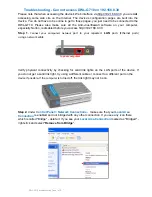
Chapter
2
Chapter 2 installation Guideline 2-
9
2.3 Baud rate and Checksum
ADAM modules contain EEPROMs to store configuration
information and calibration constants. The EEPROM replaces the
conventional array of switches and pots that are originally used for
specifying baud rate, input and output range… etc.
Since there is no visual indication of a module’s configuration status,
it is impossible to know the baud rate, address and other settings just by
looking at it. It might not be possible to establish communications with
a module whose baud rate and address are unknown. To overcome this
problem, most modules have an input terminal labeled INIT*. Booting
the module while connecting the INIT* terminal with the module’s
GND terminal forces the configuration into a known state called the
INIT* state. Besides, some newer modules have INIT switch which you
can set “Init” or “Normal” (See Figure 2.4). If you set the switch to
“Init”, then it becomes INIT* state.
INIT* state defaults:
Baud rate: 9600
Address: 00h
Checksum: disabled
Forcing the module in INIT* state does not change any parameters
in the module’s EEPROM. When the module is in the INIT* state with
its INIT* and GND terminals shorted, all configuration settings can be
changed, and the module will respond to all other commands normally.
Changing Baud rate and Checksum
Baud rate and checksum settings have several things in common:
• They should be the same for all modules and host computer.
• Their settings can only be changed by putting a module in the INIT*
state.
• Changed settings can only take effect after a module is rebooted
To alter baud rate or checksum settings, you must perform the
following steps:
Summary of Contents for Data Acquisition Modules ADAM 4000
Page 1: ...ADAM 4000 Data Acquisition Modules User s Manual ...
Page 7: ...Introduction 1 ...
Page 11: ...Installation Guideline 2 ...
Page 28: ...I O Modules 3 ...
Page 98: ...Chapter 3 Chapter 3 I O Modules 3 71 Figure 3 69 ADAM 4069 Form A Relay Output ...
Page 104: ...Command Set 4 ...
Page 147: ...Analog Input Module Command Set 5 ...
Page 215: ...Analog Output Module Command Set 6 ...
Page 236: ...Digital I O Relay ouput and Counter Frequency Command Set 7 ...
Page 313: ...Calibration 8 ...
Page 329: ...Technical Specifications A ...
Page 335: ...Appendix A Appendix A Technical Specification A 7 Figure A 2 ADAM 4011D Function Diagram ...
Page 337: ...Appendix A Appendix A Technical Specification A 9 Figure A 3 ADAM 4012 Function Diagram ...
Page 339: ...Appendix A Appendix A Technical Specification A 11 Figure A 4 ADAM 4013 Function Diagram ...
Page 341: ...Appendix A Appendix A Technical Specification A 13 Figure A 5 ADAM 4016 Function Diagram ...
Page 343: ...Appendix A Appendix A Technical Specification A 15 Figure A 6 ADAM 4017 4017 Function Diagram ...
Page 349: ...Appendix A Appendix A Technical Specification A 21 Figure A 8 ADAM 4018M Function Diagram ...
Page 351: ...Appendix A Appendix A Technical Specification A 23 Figure A 9 ADAM 4019 Function Diagram ...
Page 355: ...Appendix A Appendix A Technical Specification A 27 Figure A 11 ADAM 4024 Function Diagram ...
Page 357: ...Appendix A Appendix A Technical Specification A 29 Figure A 12 ADAM 4050 Function Diagram ...
Page 377: ...Data Formats and I O Ranges B ...
Page 389: ...Technical Diagrams C ...
Page 392: ...Technical Diagrams C 4 ADAM 4000 Series User s Manual Figure C 3 DIN Rail Mounting ...
Page 394: ...Technical Diagrams C 6 ADAM 4000 Series User s Manual Figure C 5 Panel Mounting ...
Page 395: ...Appendix C Appendix C Technical Diagrams C 7 C 2 3 Piggyback Stack Figure C 6 Piggyback Stack ...
Page 396: ...Utility Software D ...
Page 404: ...RS 485 Network E ...
Page 411: ...How to use the Checksum feature F ...
Page 415: ...ADAM 4000 I O Modbus Mapping Table G ...
Page 428: ...Changing Configuration to Modbus Protocol H ...















































